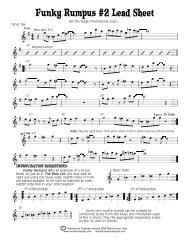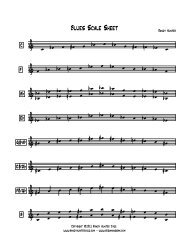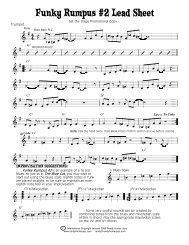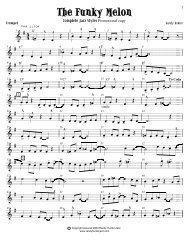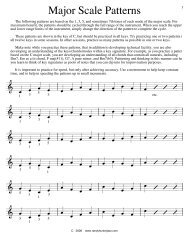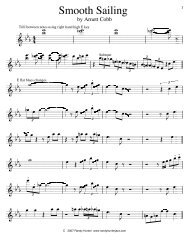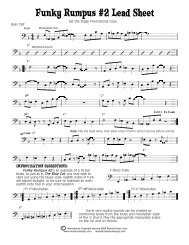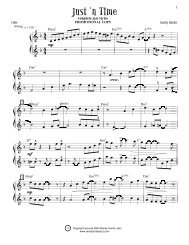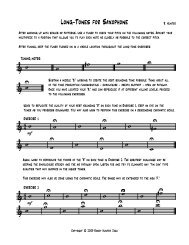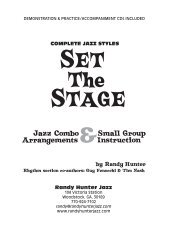What's Up With II-V-I's - Randy Hunter Jazz
What's Up With II-V-I's - Randy Hunter Jazz
What's Up With II-V-I's - Randy Hunter Jazz
You also want an ePaper? Increase the reach of your titles
YUMPU automatically turns print PDFs into web optimized ePapers that Google loves.
THE JAZZ VOCABULARY<strong>What's</strong> <strong>Up</strong> <strong>With</strong> <strong>II</strong>-V-<strong>I's</strong>An Introduction to the <strong>Jazz</strong> Language1<strong>Randy</strong> <strong>Hunter</strong>Learning to improvise is often compared with learning to speak a language. As jazz musicians, ourobjective is to learn to speak through our instruments with the fluency of a great story-teller, using anunresticted vocabulary to enhance our musical narrative with emotion, energy, and creativity.When learning a language, we begin with basic words and word combinations that allow us to expresssimple ideas. As our vocabulary and understanding of sentence structure grows, we learn tocommunicate more complex ideas. A similar process can be applied when learning the jazz language.FIRST THINGS FIRST:Developing an understanding of the most basic chords/scales used in jazz and the way these chordswork together is critical in learning to speak the jazz language. Minor seventh (m7), dominant seventh (7), .and major seventh (maj7) chords are fundamental to this approach because, in their unaltered forms,they are constructed from modes of major scales. These chords are often grouped together in acommon progression known as a <strong>II</strong>-V-I.In this type of progression, the <strong>II</strong> and V chords and scales are constructed based on the correspondingsecond and fifth steps of the major (I) scale. The example below shows a <strong>II</strong>-V-I progression in the key ofC major.Notice in the example that the Dm7 and G7 scales/chords are generated from tones found in the Cmajor scale. These scales are known as the dorian (second) and mixolydian (fifth) modes.Dm 7 (<strong>II</strong>) Dorian ModeG97======================== & 53=1œœ œ œ œ œ œ œ œ 9 œ_ 7 (V) Mixolydian Mode Cmaj15 œ 37 œ œ œ œ œ œ œ œ_7 Major Scale95 7œ_ 3 œ œ œ œ œ œ œ œl l l2(I)115PRACTICE:1. Since <strong>II</strong>-V-I progressions are perhaps the most common chord combinations in jazz, It is important to .learn to recognize and play them in all keys. Assuming you have a working knowledge of your majorscales, pick a key and play the major (I) scale. Follow this with the <strong>II</strong> and V scales and arpeggios. Thearpeggios should consist of the 1, 3, 5, 7, and 9 in relation to each scale, as shown in the example above.Reinforce your knowledge of the progression by repeating the arpeggios in <strong>II</strong>-V-I sequence.NOTE: A <strong>II</strong>-V-I practice progression has been provided on the last page of this lesson.HINT: Recognizing <strong>II</strong>-V-<strong>I's</strong> is easy. Examine various tunes in a fake book for m7-7-maj7 progressions andask yourself if they have the <strong>II</strong>-V-I relationship. <strong>II</strong>-V's are also often seen without the I chord resolution.Look for m7-7 chord combinations and determine whether or not they share the same hypothetical Ichord.C 2009 <strong>Randy</strong> <strong>Hunter</strong> <strong>Jazz</strong>www.randyhunterjazz.com
˙»˙»˙»˙»2WHAT"S THE DIFFERENCE?Since <strong>II</strong>-V-I progressions are created from scales that have all the same tones, you may wonderwhy you can't just play major scales throughout the progressions. In short fact, you can. Butremember, we're working to develop a vocabulary that offers unlimited potential for expression. .If all you play is one scale over a chord progression, that's very limiting.By using the arpeggios/chord tones, we are able to play lines that offer a distinct identity to eachchord. Given this, it is fair to say that not all chord tones are created equal. In unaltered minor,dominant, and major chords, the third and seventh tones are the most important for a couple ofreasons.Most importantly, thirds and sevenths provide the identity for these chords. Major 7 chordscontain major thirds and major sevenths. Minor 7 chords contain minor thirds and minorsevenths. Dominant 7 chords contain major thirds and minor sevenths.Thirds and sevenths are also referred to as guide tones because they guide the movement of theharmony from chord to chord. In <strong>II</strong>-V-I progressions, descending chromatic movement is foundbetween the sevenths of the minor and dominant chords to the respective dominant and majorchords.NOTE: Thirds and sevenths are so vital in establishing the identity of unaltered minor, dominant,and major chords that they serve as the basis for piano voicings of these chords.PRACTICE:2. Practice playing only the thirds and sevenths in <strong>II</strong>-V-I sequences in all keys. First, play the thirdfollowed by the seventh, as shown in the "Thirds and Sevenths Example" below. Once you gainconfidence in your ability to play these tones with accuracy, practice improvising using only thirdsand sevenths.Thirds and Sevenths ExampleDm 7 G=======================&˙»7 l˙»l l3773Cmaj 7 37NOTE: Insure that you are practicing in all twelve keys by using the practice progression .included at the end of the lesson.
»»»»»»»»»»»»»»»»»»»»»»»»»»3Ex. 1PATTERNS AND IMPROVISING:Scales, arpeggios, and a working knowledge of guide tones constitute the foundation of a fluent jazz .improvisation vocabulary. After this knowledge is acquired comes the process of creating musicalsentences.Just as you practice building sentences when learning a language, you also practice creating musicallines known as phrases. One of the most effective methods of exercising your jazz vocabulary is topractice patterns. Patterns are licks, phrases, or any combination of notes that you transpose andpractice in multiple keys.PRACTICING:When practicing patterns for improvisation, it is important to work with concepts in mind, ratherthan just to learn licks. Several arpeggio based patterns have been provided in the examples belowthat utilize guide tones to connect the changes. Practice these in all twelve keys, then work to comeup with additional patterns that incorporate the same concepts.Follow pattern practice with improvisation practice, working to include the same concepts.G« « « «7 Cmaj========================& ˙«ˆ ˆ ˆ ˆ œ œ œ œ7 œ œ˙» »˙» »œ œl l lwlDm 7 31573517ˆDm G« « «7Ex. 2========================& ˆ«ˆ ˆ œ»œ ‰ œ J »œ œ ‰ œ »» J œ_»œ ‰ œ J Cmaj 7»œ» œ ˙« œ œ œ »œ_ œ œ»l l » Ó» l l£Dm 7‰ œEx. 3========================&J « « « «7ˆ G» ˆ« «ˆ ˆ ˆ ˆ ˆ « « «ˆ« ˆ ˆ »œ œ_ œ œ Cmaj œ œ_ 7œ_ J» ‰ » ‰ œ » J œ œ œ œ» » » œl l l »˙» lEx. 477ˆDm« « «========================& ˆ«ˆ ˆ œ » »œ œ œ_ œ_ Gœ_ 7 . »œ_ J »œ£ » œ œ œ Cmajœ « 7« » ˆ ˆ œ œ œ œ œ_ J »_‰ œ » » œ ‰ œ » J œl l » l » l35917HINT: Transpose patterns from one key to another by assigning numbers to the chord/scale tones inrelation to their positions on the respective dorian, mixolydian, and major scales. Learn to think by the .numbers rather than always having to write things out. You'll soon learn to do this with relative ease.NOTE: <strong>II</strong>-V-I play-along resources are available in Volume 3 of the Jamey Aebersold series, and onlinethrough a website called Play <strong>Jazz</strong> Now. A link to Play <strong>Jazz</strong> Now can be found at www.randyhunterjazz.comby scrolling to the bottom of the homepage.
4<strong>II</strong>-V-I Practice ProgressionDm 7 G 7 Cmaj 7===========================& “{ l l l ”{Cm 7 F 7 B b maj 7===========================& “{ l l l ”{B b m 7 E b 7 A b maj 7===========================& “{ l l l ”{A b m 7 D b 7 G b maj 7===========================& “{ l l l ”{F # m 7 B 7 Emaj 7===========================& “{ l l l ”{Em 7 A 7 Dmaj 7===========================& “{ l l l ”{E b m 7 A b 7 D b maj 7===========================& “{ l l l ”{C # m 7 F # 7 Bmaj 7===========================& “{ l l l ”{Bm 7 E 7 Amaj 7===========================& “{ l l l ”{Am 7 D 7 Gmaj 7===========================& “{ l l l ”{Gm 7 C 7 Fmaj 7===========================& “{ l l l ”{Fm 7 B b 7 E b maj 7===========================& “{ l l l ”{



